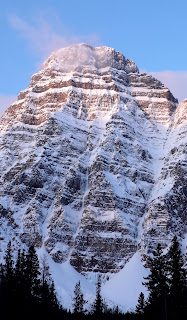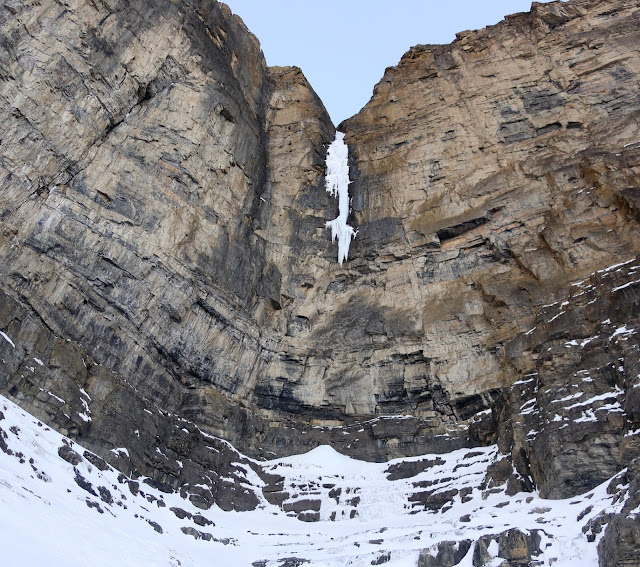Just sport climbing
A casual reader of this blog might get the impression that its author is an alpinist. Such an impression would be largely mistaken. Sure, I might scramble up the occasional peak, but if the amount of time spent doing something is any indicator, I am first and foremost a sport climber. In fact, since coming back from my last foray into the Bugs in mid-August, I have done nothing in my free time but clip bolts.
There is a kind of uncompromising honesty about sport climbing that sets it apart from other, more forgiving forms of climbing - such as alpinism. Take the Dogleg on the northeast face of Mt. Chephren, a route Pierre Darbellay and I climbed in late winter 2008. It stands out as one of the most intense experiences I have had in the mountains. On the first day we climbed high up a mostly easy couloir, bivied, then the next morning started up the vertical chimneys that top the line. As our second day on the face wore on, blue skies were replaced by driving snow. With nowhere to bivi and the gullies below us running with avalanches, we continued into the night. One pitch from the summit ridge we hit a dead end. The first exit we tried blanked out, while the second turned into an overhanging offwidth. Luckily the third and last option went, releasing us from the face, but not before the combination of storm, darkness and weakness had me dangling from knifeblades to get past an impending wall. Now as an alpine climb the Dogleg was a success: a big new route climbed in bad conditions. But had this been a sport climb, having to yard past the crux on quickdraws would have meant I was still a long way from a proper redpoint.
The sun rises on the northeast face of Mt. Chephren. Photo: Pierre Darbellay.
Snow mushrooms and thin ice under clear skies on the first day. Photo: Pierre Darbellay.
More snow mushrooms but no ice and no blue skies on the second day.
As the second days draws to a close, Pierre Darbellay emerges from a maelstrom of swirling snowflakes.
Or take the southwest face of “Lunda Sar”, an obscure 6300-metre peak in the wilds of the Karakoram. Starting from a bivi below the face, Eamonn Walsh, Ian Welsted and I soloed serac-threatened ice slopes to the base of the business, a wall of ice-streaked granite. There, in the thin air, were climbed eight long pitches of some of the classiest mixed climbing any of us had ever done in the mountains: thin runnels interrupted by overlaps, with mostly good gear but also the occasional mind-focusing runout. Sometime in the early evening we hit the summit ridge, only a hundred metres below the virgin summit. But though the summit was close, it was not close enough. With a metre of unconsolidated snow overlying black ice on a corniced ridge, we ground to a halt after less than a ropelength of this nonsense. Though the lack of a summit was disappointing, we were psyched about the fantastic climbing, and simply relieved to be back at our bivi nearly twenty-four hours after leaving it. But again, had this been a sport climb, lowering from the last draw before the anchor, because after all "we had already done the crux," would have never done.
"Lunda Sar" ("Second-Hand Peak") glows in the evening sun. Photo: Eamonn Walsh.
A checkerboard of granite and ice. Photo: Eamonn Walsh.
Cracking the technical (but definitely not the redpoint) crux. Photo: Ian Welsted.
Ian Welsted follows a pitch high on the face. Photo: Eamonn Walsh.
And so it is that even as the days are getting shorter and colder, translucent grey ice is growing fatter and bluer in shady nooks, and high on the Divide winter snows have already come, I still find myself holding on to the sport-climbing season gone by: shivering by a cliff-side fire, stuffing shake-and-warms into a chalk bag, and punching for the chains. Hopefully the photos below, taken at what is arguably the best sport crag in the Rockies, show why one might be willing to go to such lengths just to rock climb for another couple of weeks.
Photo: Wiktor Skupinski.
Photo: Wiktor Skupinski.
Photo: Wiktor Skupinski.
Photo: Wiktor Skupinski.
Photo: Wiktor Skupinski.
Photo: Wiktor Skupinski.

















Hahaha! You are the first person I have ever heard describe alpine climbing as "forgiving" - awesome pictures! Thanks for sharing them :)
ReplyDeleteI suppose it depends on whether it is nature or the climbing police who is doing the forgiving. In sport climbing we have eliminated most of the risk, so we can afford to get uptight about the rules we play by. In alpine climbing, well, I aspire to play by a strict set of rules, but occasionally I get scared, and then I break them.
ReplyDelete